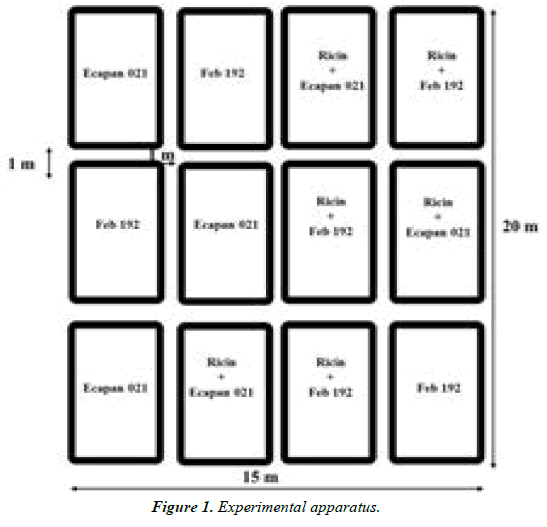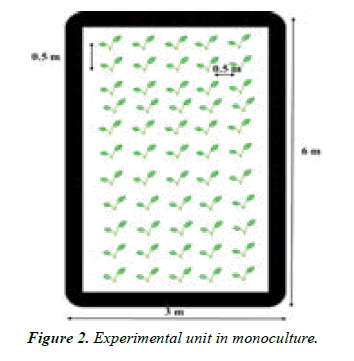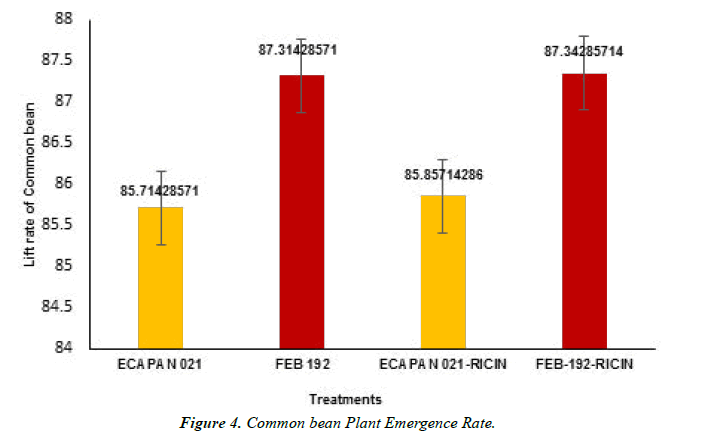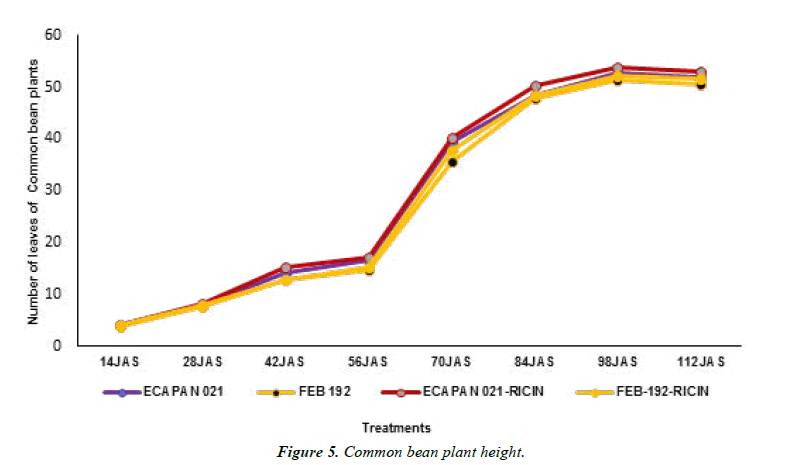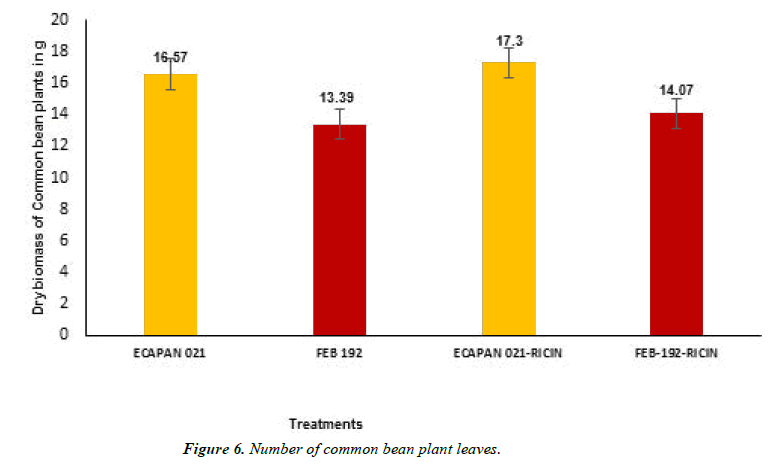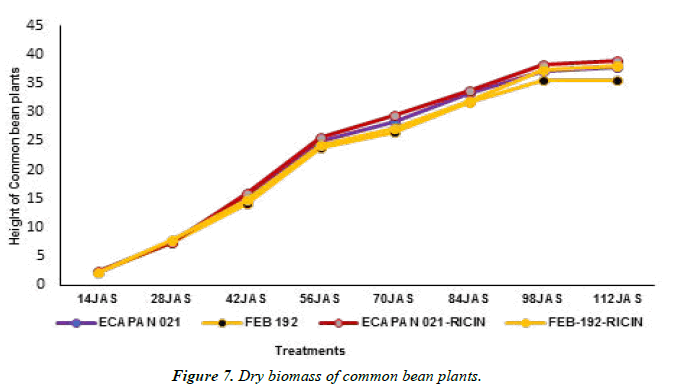Research Article - Journal of Agricultural Science and Botany (2022) Volume 6, Issue 7
Incidence of crop association on the growth and productivity of two Common bean (Phaseolus vulgaris L.) varieties grown in fields in the high plateau area of Cameroon.
Derogoh Nway Amang Nehemiah1*, Tchuenteu Tatchum Lucien2 and Megueni Clautide2
1Department of Plant Biology, Faculty of Sciences, University of Dschang, Cameroun Colline de Foto, Cameroon
2Department of Biological Sciences, University of Ngaoundere, Yaounde, Cameroon
- *Corresponding Author:
- Derogoh Nway Amang Nehemiah
Department of Plant Biology
Faculty of Sciences
University of Dschang
Colline de Foto, Cameroon
E-mail: nehemienway@gmail.com
Received: 15-Jun-2022, Manuscript No. AAASCB-22- 66659; Editor assigned: 17-Jun-2022, PreQC No. AAASCB-22- 66659(PQ); Reviewed: 05-July-2022, QC No. AAASCB-22-66659; Published: 20-July-2022, DOI:10.35841/2591-7897-6.7.131
Citation: Nehemiah DNA, Lucien TT, Clautide M. Incidence of crop association on the growth and productivity of two Common bean (Phaseolus vulgaris L.) varieties grown in fields in the high plateau area of Cameroon. J Agric Sci Bot. 2022;6(7):131
Abstract
Our study was conducted in West Cameroon; respectively in the high plateau area in Dschang from April to December 2021. A completely randomized experimental design with three repetitions of four treatments was used: in monoculture (common bean Feb-192, common bean Ecapan 021) then in crop association (Castor bean-Feb 192 and Castor bean-Ecapan 021). Common bean growth and production parameters were evaluated. The comparison of the performance of each cropping system was made on the basis of the Land Equivalent Ratio (LER). The results show that the growth and productivity of the common bean are influenced by the cropping association and the sandy clay soil as well as the tropical climate of the study area. The yield of common bean seeds of the Ecapan and Feb 192 varieties in intercropping with Castor bean is 0.67% and 0.35% higher than that of the two varieties of common beans in monoculture respectively for the treatments. Ecapan-Ricin and Feb 192-Ricin. The LER varies from 1.02 in a Castor beanEcapan crop association to 1.01 in Castor bean-Feb 192 crop association.
Keywords
Crop association, High plateau area, Production parameters.
Introduction
The respective place of proteins of animal and vegetable origin in the diet is the subject of much debate. If the food vectors of proteins of animal origin or of vegetable origin can cover the nitrogen and protein requirements, they are complementary, each being a source of other nutrients of interest. In France, as in most Western countries, food intake between animal protein and vegetable protein is close to a ratio. From an environmental point of view, the production of food vectors of animal proteins has consequences that are often highlighted as being negative. However, positive points, for example in terms of ecosystem services, should also be highlighted. Therefore, a reasonable reduction in protein consumption of animal origin is recommended, rather than a goal of eviction. The exploitation of synergies between animal and plant productions such as (soya, cowpea and common beans) at the scale of a territory will constitute one of the major levers for the establishment of safe, healthy and sustainable food systems, ensuring the food security of populations while allowing the control of environmental impacts [1].
The common bean (Phaseolus vulgaris L.) is among the legume family, one of the most consumed in the world; because it has high nutritional quality. Proteins from common beans have a high lysine content which is relatively deficient in maize, cassava or rice. The common bean is also lower in fat and free of cholesterol and thus reduces the risk of diseases like cancer, diabetes, heart disease. Regular consumption of this legume is thus widely recommended by [2]. As with most legumes, the nitrogenous nutrition of common beans is achieved either by assimilation of soil nitrates (by the plant's nitrate reductase) or by biological fixation of atmospheric nitrogen (by the bacterium's nitrogenase). These two processes are complementary during the growth cycle of the plant. Nitrate reductase intervenes mainly before flowering and nitrogenase takes over at the beginning of flowering and continues until the beginning of pod formation [3].
Associated with crops that do not fix nitrogen, such as Castor bean common bean, common beans set up a process of complementarity for the nitrogen in the environment. This technique has shown its performance in organic farming, where nitrogen input is less frequent while maintaining satisfactory yields in quality and quantity [4].
In this regard, [5], study the growth variability and yield of Castor bean common bean in crop accessions with maize and common bean in the Sudano-Guinean zone of Cameroon and report that the association of the common bean with Castor bean common bean is favourable for two plants with an increase in seed yield for Castor bean common bean and common bean, respectively of 43% and 14% compared to monoculture [5].
In addition, the work of [4] revealed that certain legume species such as common beans perform better in intercropping than cowpea and soya bean. Therefore, the present study aims to promote the cultivation of Castor bean common bean, which is a multipurpose plant by studying the growth and productivity of two common bean varieties (Ecapan 021 and Feb 192) in crop association with Castor bean in the agroecological zone of the highlands of the West region of Cameroon [4, 6-10].
Material and Methods
Description of the experimental site
The field study took place in April 2022. In the multipurpose station of the Institute of Agronomic Research for Development (IRAD) of Dschang, located in the Department of MENOUA (West region of Cameroon)
This locality of Dschang is known to have a tropical type climate, heavy rainfall most months, with a short dry season. The average annual temperature in Dschang is 19.7°C. Annual rainfall averages 4473 mm [11,12].
Biological material
The seeds of the Motso I Castor bean common bean accession, the common bean varieties (Feb 192 and Ecapan 021) obtained from IRAD Foumban were used in this study. These varieties were chosen for their early germination, their adaptability to the rainy season and their short reproduction cycle (Table 1). The use of a variety presented with a short reproduction cycle is advantageous for the farmers insofar as they can have several harvests per year if they are cultivated against the season. [5].
| Accession Motso I | Varieties Ecapan 021 | Feb 192 |
|---|---|---|
 |
 |
 |
| Colour type: kidney red Vegetative cycle: 75 days Seed sizes: large seeds Potential yield: 1.5 to 2 tons per hectare |
Colour type: Red mottle Vegetative cycle: 75-80 days Yield potential: 2,000 to 2,500 (kg/ha) |
Colour type: kidney red Vegetative cycle: 75 days Seed sizes: large seeds Potential yield: 1.5 to 2 tons per hectare |
Table 1. Some characteristics of the varieties of sheaths used.
Experimental device
Figures 1-3 shows the experimental device consists of 04 treatments, therefore 2 in monoculture (Ecapan 021 and Feb 192); then 2 in combination with ricin (Ecapan 021-Ricin and Feb 192-Castor bean) randomly and repeatedly arranged in three blocks. Each of the 12 elementary plots has an area of 18 m 2 (6 m × 3 m). The total area of the field for this device is 300 m 2. The common bean varieties were sown in monoculture in five columns separated by 0.5 m. The distance between two consecutive plants within each column is 0.5 m. in intercropping, Common bean plants were sown 0.5 m from each Castor bean and Common bean plant.
Recorded data and statistical analysis
The soil analyses were carried out at the Soil Analysis and Environmental Chemistry Laboratory (LABASCE) of the University of Dschang-Cameroon according to the international methods recommended by Pauwels et al. (1992). The emergence rate of the seedlings was evaluated two weeks after sowing. Plant height and number of plant leaves were assessed on a random sample of 30 plants per treatment at regular intervals of 14 days. At the flowering stage, a random sample of 15 plants per treatment was taken; dry biomass and stem diameter at the collar were measured. At maturity,

Where Rdt: represents the seed yield, Mgr: mass of seeds, NPr: number of plants harvested and Ds: seeding density (the seeding density is equal to the number of seedlings sown per square meter or on an experimental unit).
The comparison of the performance of each cropping system was made on the basis of the Land Equivalent Ratio (LER) which is the ratio of the productivity of an area in cropping association to that of an area in monoculture according to this equation:
It is calculated as follows: let A and B be two cultivated plants.

If LER=1, there is no difference between the two culture modes
If LER<1, there is a loss of yield in combination
If LER >1, there is a productive advantage of associations
Data were subjected to analysis of variance followed by Duncan's tests when a significant effect was observed. The statistical software "xlstat 2018" was used.
The correlation between the parameters was evaluated from the correlation diagram, X and Y. each element i is represented by the point of coordinates (Xi,Yi). The set of points forms a cloud of points whose shape makes it possible to characterize the intensity of the relationship.
Results and Discussion
Physico-chemical properties of the soil of the studied site
Table 2 summarizes the physico-chemical properties of the soil of the experimental site of the IRAD station in Dschang (texture, pH, nitrogen and phosphorus).
| Texture (%) | : Sand =23; silt. = 14; Clay= 64 Textural class: sandy clay |
| pH | pH-water: 5.7 This soil is an acid soil. -pH-Kcl: 4.9 |
| Organic carbon (%) | :5.40 |
| Material Org. (%): | 9.30 |
| Total nitrogen (g/kg): | 0.37 |
| Available phosphorus in mg/kgBray II: | 11.00 |
| C/N ratio: | 15 |
| Exchangeable cations milliequivalents/100g | |
| Calcium | 5.60 |
| Magnesium | 3.15 |
| Potassium | 1.69 |
| Sodium | 0.04 |
| Base sums | 10.49 |
| Cation exchange capacity in meq/100 g | |
| Effective CEC | 10.49 |
| S/CECE (%) | 100 |
| CEC pH7 | 34.25 |
| Saturation bases (%) | 31.00 |
Table 2.Physico-chemical properties of the soils of the study sites.
Seedling emergence rate
Emergence rate of common bean legumes
Emergence rates of common bean plants are shown in Figure 4.
There is no significant difference between the cropping systems (monoculture and cropping association) on the legumes emergence studied. The average emergence rate of the legumes in this study are respectively (85.71%, 87.31%, 85.85 and 87.34%) respectively for the treatments (Ecapan 021, Feb 192, Ecapan 021-Ricin and Feb 192-Castor bean).
The results obtained on the emergence of common bean plants corroborate the data found in the literature. Indeed, reported that the emergence of generally common bean took place between 6 and 14 days after sowing with a seedling emergence rate of 79 to 82%. In this study, the emergence of common bean seeds was observed 7 days after sowing [4,10].
It was observed in this study that the edaphic and climatic characteristics of the West Cameroon region would be favorable to the emergence of common bean seedlings. There is no difference between the cropping systems on the seedling emergence of the common bean plants used, which suggests that the space between two consecutive plants in an elementary plot is large enough to avoid competition between legumes and Castor bean in the first stage of their development.
However, the influence of edaphic and climatic variations observed on the growth and yield of cultivated plants must be studied.
Effect of intercropping on common bean growth and productivity
Effect of intercropping on common bean growth
Plant height and number of leaves per plant: Figures 5 and 6 shows the height of the plants and the number of leaves of the common bean according to the cropping systems.
In general, there is no significant difference (p<0.05) between the intercropping systems on these two growth parameters. However, the height of the plants and the number of leaves per plant of the legumes studied are higher in intercropping with Castor bean common bean than in monoculture.
In this study, the height of the common bean plants varies from 35.57 ± 0.29 to 38.97 ± 0.41 cm respectively for the Feb 192 monoculture treatments and the Castor bean-Ecapan crop association, while the number of leaves of the plants of common beans varies from 50.55 ± 0.17 to 52.92 ± 1.21 respectively for the Feb 192 monoculture treatments and the Castor bean-Ecapan crop association.
In this study, there is a strong and positive correlation (0.99; p-value = 0.007) between the height and the number of leaves, then (r = 0.86; p-value = 0.13) between the number of leaves and the yield in common bean seeds.
Figure 7 shows the results obtained at the height of the plants and the number of leaves per common bean plant corroborate the data recorded in the literature (2010) [13,14]. In addition reported that common bean emergence at 149 cm depending on treatments and varieties of common beans used [4,5,10,13].
In this study, dry biomass of common bean plants varied from 13.39 ± 0.67 to 17.3 ± 0.37 g respectively for the Feb 192 monoculture and Ecapan-Ricin mixed crop treatments.
In this study, there is a strong and positive correlation (r = 0.97; p-value = 0.03) between dry biomass of common bean plants and common bean seed yield.
The results obtained on the dry biomass of common bean plants are superior to those of the work of which reports that the dry biomass of the common bean varies between 5.64 to 10.2 g depending on the treatments and varieties of common beans used [4,5,10].
It was observed in this study that the edaphic and climatic characteristics of the West Cameroon region would be favorable to the growth of common bean plants. In addition, the highest values for these parameters in intercropping than in monoculture reflect the beneficial effect of intercropping on common bean growth, however, the influence of edaphic and climatic variations observed there and common bean yield should be assessed.
Effect of intercropping on common bean productivity
Table 3 represents the common bean production parameters (dry biomass, stem diameter of the plants at the collar, number of ears per plant, number of fruits per ear and seed yield) at maturity at 112 DAS (day after sowing) depending on the cropping systems.
| Treatments | Settings | ||
|---|---|---|---|
| Fruits per plant | Seeds per fruit | Seed yield (kg/ha) | |
| Ecapan 021 | 13.83a | 7.67a | 170.12 at |
| Feb 192 | 7.71a | 5.23 to | 168.48 |
| Ecapan 021-Ricin | 13.88a | 7.25 to | 171.27 at |
| Feb-192-ricin | 7.82a | 5.85 to | 169.08 at |
Table 3. Fruits per plant, seeds per fruit and common bean seed yield.
In general, it appears that there is no significant difference (p<0.05) between the culture systems of these parameters. However, higher values on these parameters are observed in intercropping with Castor bean common bean than in monoculture.
Effects of cropping association on the number of fruits per plant in the common bean
In this study, the number of fruits per plant of legumes ranged from 59.33 ± 0.27, 59.37 ± 0.29 and 7.57 ± 0.29 respectively to 75.97 ± 0.27.
In this study, there is a strong and positive correlation (r = r = 0.90; p-value = 0.09) between the number of fruits per common bean plant and the common bean seed yield.
The results obtained on the number of fruits per common bean plant in this study corroborate the data found in the literature. Indeed, reported that the number of fruits per common bean plant ranged from 5 to 9.
Effects of cropping association on the number of seeds per common bean fruit
In this study, the number of seeds per fruit varied from 2.33 ± 0.17 in monoculture to 2.67 ± 0.19.7 respectively in intercropping. There is a positive and significant correlation (r = 0.30, p < 0.05) between the number of seeds per fruit and the seed yield respectively the common bean.
In this study, there is a strong and positive correlation (r = 0.85; p-value = 0.14) between the number of seeds per fruit of common bean plants and the seed yield of the common bean.
The values obtained on the number of seeds per common bean fruit are higher than that found by who reported that the number of seeds per common bean fruit varied from 2.44 to 2.46.
Effects of intercropping on common bean seed yield
In this study the common bean seed yield varies from 175.67±0.27 in monoculture to 195.67±1.33, kg/ha in intercropping.
These results are consistent with the work of [14] who reveals that the seed yield of common bean varied from 0.75 to 0.99 t/ha.
The lower legume seeds yield values obtained in this study would be justified by the fact that no fertilizer was applied to our plants in order to optimize plant growth and seed yield. Several authors, [15] revealed that fertilizers improve soil fertility and increase plant productivity.
Discussion
Overall, in this study, the intercropping and the experimental site.
Is beneficial for common bean production, Indeed, study the effects of temperature and rainfall on food production in southern Cameroon and reported that climatic conditions influence plant productivity. Help reduce plant growth.
The beneficial effect of the crop association with the growth of plants and the production of the common bean could be explained by the fact that in Castor bean-common bean association, the Castor bean creates a microclimate favorable to the growth of legumes and also plays a staking role for the common bean thus repelling pathogens and would reduce damage from plant diseases, but this needs to be investigated. Intercropping turns out to be a necessary tool for improving cultural systems.
Land equivalent Ratio of the crop association according to cropping systems
Table 4 represents the Land equivalent Ratio (LER) of the Castor bean common bean association. In this study, the LER varies from 1.01 in the Castor bean oil-Feb 192 combination of 1.02 in the Castor bean oil-Ecapan 021 combination. These results obtained on LER corroborate the data found in the literature. Indeed, several authors have revealed that the LER of Legumes in intercropping is greater than 1.
| Ecapan 021-Ricin | Feb-192-Castor bean |
|---|---|
| 1.02 | 1.01 |
Table 4. Land Equivalent Ratio according to intercropping.
[4,5]. The LER compares the yields of associated crops with the yields of monocultures. If the LER>1, the association is effective while if the LER?1 the crop association is not beneficial. In this study, the LERs of all intercropping systems studied are greater than 1, suggesting that Castor beancommon bean intercropping systems are beneficial in our study area.
The beneficial effect of the Castor bean-Ecapan intercropping system compared to the other cropping systems studied suggests that this common bean variety would fix more nitrogen and make it available to Castor bean common bean than the Feb 192 variety in our study area. But this needs to be assessed.
Conclusion
This study aimed to assess the impact of intercropping on the growth and productivity of common beans in the agroecological zone of the highlands of the West Cameroon region. Common bean growth and production parameters were evaluated. The comparison of the performance of each cropping system was made on the basis of the Land Equivalent Ratio (LER). The results show that common bean productivity is influenced by the crop association and the edaphic and climatic characteristics (sandy clay soil and tropical climate) of the study area. The yield of common bean seeds of the Ecapan and Feb 192 varieties in intercropping with Castor bean is 0.67% and 0.35% higher than that of the two varieties of common beans in monoculture respectively for the treatments. Ecapan-Ricin- and Feb 192-Ricin. The legumes used are more productive when intercropped with the Ecapan common bean varieties. The LER varies from 1.02 in the Castor bean-Ecapan crop association system to 1.01 in the Castor bean common bean-Feb 192 crop association. The Castor bean common bean crop association is therefore beneficial for Cameroonian farmers in the West region. By growing Castor bean oil in association with common beans, Cameroonian farmers contribute not only to developing biofuels, but also to preserving food security. The Castor bean common bean crop association is therefore beneficial for Cameroonian farmers in the West region. By growing Castor bean oil in association with common beans, Cameroonian farmers contribute not only to developing biofuels, but also to preserving food security. The Castor bean common bean crop association is therefore beneficial for Cameroonian farmers in the West region. By growing Castor bean oil in association with common beans, Cameroonian farmers contribute not only to developing biofuels, but also to preserving food security.
References
- Chardigny Jean-Michel and Guy-Grand Bernard. Proteins in the diet: towards an animal-vegetable balance. State of play drawn up by the French Food and Health Fund. 2019. 24.
- Leterme P, Mu?oz LC. Factors influencing pulse consumption in Latin America. B J N. 2002;88(S3):251-4.
- IRAD (Institute of Agricultural Research for Development). Contribution of research to improving the production and consumption of food legumes in Cameroon. C2D leguminous project, IRAD N° 6. Scientific expertise mission from September 15 to 21, 32.
- Derogoh N.A.N, Megueni C, Tchuenteu T.L. Study of intercropping system castor bean and vegetables are seeds yield and yield related traits in two agroecological zones of Cameroon. Scholars. J Agric Vet Sci, 2018;5(6):352-368.
- Tchuenteu LT, Megueni C, Njintang NY. Effects of Intercropping Systems of Castor Bean, Maize and Common Bean on Their Growth and Seed Yield in the Soudano Guinea Zone of Cameroon. J Agr Sci Tech.B. 2013;3(8B):582.
- Derogoh N.A.N. & Megueni C. Study of the effect of intercropping on the physicochemical characteristics of castor bean, soybean, cowpea and common bean seeds after cultured in two agroecological zones of Cameroon. J Int Adv Sci. 2019;5(1):10.
- Derogoh NA, Tchuenteu TL, Megueni C. Effects of different doses of mycorrhizae on the growth and yield of a local accession of castor bean (Ricinus communis L.) grown in the field of Bini-Dang (Adamaoua, Cameroon). J Int Agric Plant Sci. 2020;2(2):19-27.
- Derogoh N.A.N & Megueni C. Influence of the cultural intercropping with Castor bean on the Efficiency of Use of Rhizobial Symbiosis (EUSR) and the amount of nitrogen fixed by soya bean, cowpea and common bean grown in fields in the zone of the bimodal and Sudano-Guinean forest of Cameroon. J Int Biol Res. 2020b;2(1):15.
- Diatta AA, Abaye O, Thomason WE, et al. 2019.Effect to mung common bean intercropping on millet yield in the Groundnut Basin, Senegal. Agron Innov. 74, 69-81.
- Francis CA .Biological efficiency in multiple cropping systems. Adv Agron. 1989;42:1-42.
- Mazollier AC. Organic cultivation of common beans and gourmet peas in a cold tunnel: (test 2010). Folder of common bean pea varieties under market gardening shelters. Bio Infos. 2010;66(4): 1-10.
- Megueni C, Awono ET, Ndjouenkeu R. Simultaneous effect of dilution and combination of Rhizobia and mycorrhiza on foliar production and physico-chemical properties of young leaves of Vigna unguiculata (L.) Walp. J Appl Biosci. 2011;40:2668-76.
- Climate-data. 2022. Website consulted on 14 02 2022. https://fr.climate-data.org/afrique/cameroun/west/dschang-52924/#climate-table
- Fernández-Luqueño F, Reyes-Varela V, Martínez-Suárez C, et al. Effect of different nitrogen sources on plant characteristics and yield of common bean (Phaseolus vulgaris L.). Bioresour Technol. 2010;101(1):396-403.
- Sotameno J & Saleu feumeni J. Effects of temperature and rainfall on food production in southern. Cm Af Agron, 2013;6:23-32.
Indexed at, Google Scholar, Cross Ref
Indexed at, Google Scholar, Cross Ref
